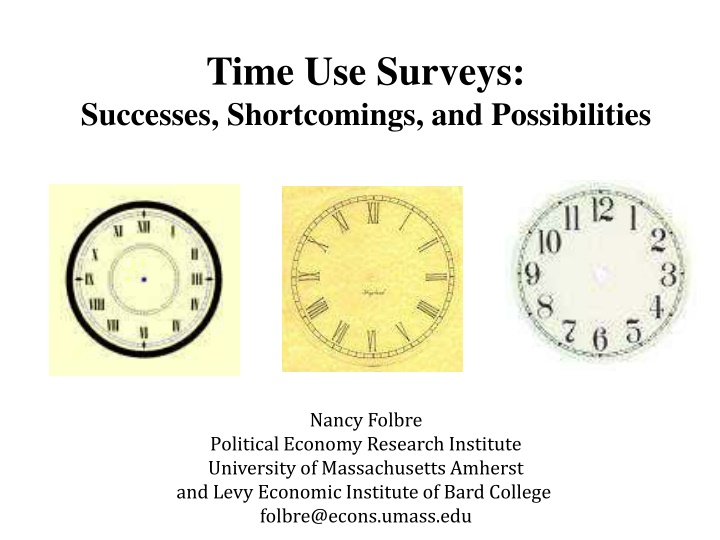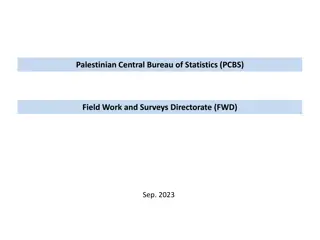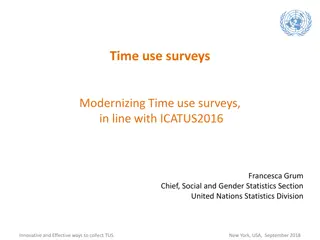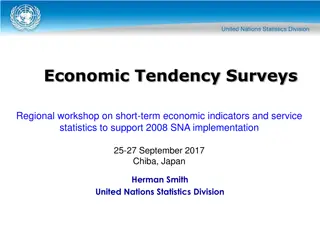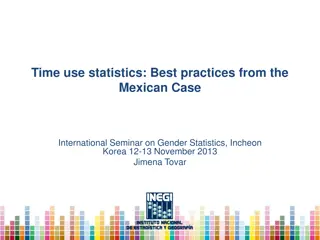Exploring Time Use Surveys: Insights, Challenges, and Prospects
Delve into the successes, failures, and potential of time use surveys presented by Nancy Folbre, discussing theoretical issues like activity conceptualization and harmonic data, the growth of national surveys, and the impacts on redefining work, gender equality, and economic development.
Download Presentation

Please find below an Image/Link to download the presentation.
The content on the website is provided AS IS for your information and personal use only. It may not be sold, licensed, or shared on other websites without obtaining consent from the author.If you encounter any issues during the download, it is possible that the publisher has removed the file from their server.
You are allowed to download the files provided on this website for personal or commercial use, subject to the condition that they are used lawfully. All files are the property of their respective owners.
The content on the website is provided AS IS for your information and personal use only. It may not be sold, licensed, or shared on other websites without obtaining consent from the author.
E N D
Presentation Transcript
Time Use Surveys: Successes, Shortcomings, and Possibilities Nancy Folbre Political Economy Research Institute University of Massachusetts Amherst and Levy Economic Institute of Bard College folbre@econs.umass.edu
Outline I. Successes (including examples from my own research) II. Theoretical Issues A. Conceptualizing activities and responsibilities B. Valuation C. Harmonizability III. Suggestions and Possibilities
The Growth of Official National Time-Use Surveys, 1930-2009 87 36 18 11 4 1 1930s 1940s 1950s 1960s 1970s 1980s 1990s 2000s Sources: U.N Statistical Office, http://unstats.un.org/unsd/demographic/sconcerns/tuse/tu3.aspx; Oxford University Centre for Time Use Research, http://www.timeuse.org/mtus/surveys. Both websites accessed February 9, 2015.
New International Labour Office Report Data from 126 time-use surveys carried out in 75 countries. Based on background paper by Jacques Charmes.
Impacts New definition of work! New measures of gender inequality! Inputs into Sustainable Development Goals Additions to National Income Accounts Stronger case for social investment Better measurement of informal sector New research on family living standards and decision-making processes and how they are affected by economic development
My Research Trajectory from measurement of women s labor force participation to measurement and valuation of unpaid work on the macro and micro level to develop a feminist economic analysis of social reproduction and the care sector.
Historical Trends in Womens Employment in the U.S. 1875 Census of Massachusetts listed Housewife as a productive occupation. Those not so engaged were termed wives, merely ornamental. Basis for revised estimates of U.S. economic growth, 1800-1930 See Journal of Economic History and Feminist Economics articles (with Wagman)
Australian Time Use Survey (1997) Emphasizes passive care as a primary AND secondary activity. Women s market work relatively small effect on child care activities other than passive care. Likewise, utilization of child care reduces passive care far more than active. Men do far more passive care than active care. See Folbre and Bittman, Family Time
Under-13 Childrens Time Use in the U.S. in activity with at least one parent 19% in activity with adult relative 2% sleeping or personal care 48% in activity with adult non- relative 2% in institutiona l care 13% awake but not engaged in activity with adult 16% CDS of PSID, 1997; See Folbre et al, Demography
How Supervisory Care Differs from Active Care in the American TUS Married and Cohabiting Persons in a Household with the Youngest Child under 13 but no Child Over 13, 2003 ATUS (n=3080) Weekday Weekend Male/ Female Male/ Female Male (n=1158) Female (n=1344) Male (n=1276) Female (n=1460) Primary child care activity Child in your care 1.09 2.70 .40 1.26 1.89 .67 3.47 6.61 .52 7.91 9.76 .81
Implications for Macro-Valuation Replacement cost estimate should value supervisory time but at a lower wage than true activity time. Revised satellite account estimates of unpaid work for U.S. based on pooled data (big increase!) (See Folbre and Suh, Review of Income and Wealth)
Micro-Valuation: Estimates of Household Extended Income Compare two married-couple families with two children under the age of 4 with annual market income of $50,000. Family A: a wage earner employed 40 hours per week, brings home $50,000 and does no household work; a full-time caregiver devotes 40 hours per week to household work. Family B, both adults employed 40 hours per week, each brings home $25,000 per year, and each devotes about 10 hours per week to unpaid family work. Family A has a higher living standard because it does not need to purchase childcare or substitutes for non-market production and works fewer hours overall. See Folbre et al in Gornick and Janti, eds., Income Inequality
Supervisory Responsibility also Relevant to Household Extended Income Big economies of scale in supervisory care Cost of supervisory care outside the household (e.g. childcare) is high. Current equivalence scales applied to market income give an incorrect picture of household living standards See Folbre et al., Review of Economics of Household.
Activity vs. Responsibility Time use is not just about activities. Parents have a legal responsibility to supervise children (and be on call for sick or frail family members). But this supervision is not as demanding as care activities--it can be combined with leisure as well as household work.
Implications for Activity Lists Capture supervisory time better than most diaries BUT, fail to distinguish between activity and responsibility (or between primary and secondary activities, which is similar but not the same). .
Valuation Contradictory to call unpaid work productive but not economic. Must acknowledge that time and money are NOT perfect substitutes BUT unpaid work affects family living standards in ways that can and should be approximated.
Italy and the United Kingdom now estimate the contribution of underground activities (prostitution and illegal drug sales) to GDP but not unpaid work.
Harmonizability! Surveys need not be identical, or even harmonized. But they should be harmonizable in order to inform public policy on both time use AND valuation. Consider one example from Europe and from Latin America.
Comparisons of 15 Countries in the HETUS (Harmonized European Time Use Survey) Relationship between GDP per Capita and Relationship between GDP per Capita and Percentage of Women's Non- Market Work Percentage of Women's Non- Market Work Devoted to Primary Child Care Activities Devoted to Primary Child Care Activities (women living in households with at least one child under 17) 50.0% 40.0% 30.0% 20.0% 10.0% 0.0% $0 $10,000 $20,000 $30,000 $40,000 Folbre, UNRISD report
Time Spent by Women in Unpaid Care Work in Urban Areas in Latin America green=diary data; blue=known explicit listing of supervisory care 450 400 350 300 250 200 150 100 50 0
Suggestions, Recommendations, Possibilities More methodological analysis. More international, academic, and interdisciplinary collaboration. More efforts to hybridize time diaries and activity lists (mestizaje!) e.g. light diaries ; activity lists for previous day rather than week, broken down by periods of time, with an explicit distinction between activities and responsibilities and a 24 hour constraint.
